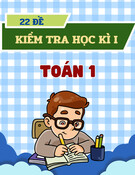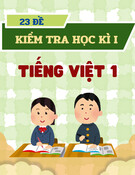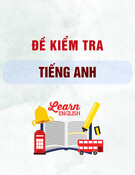SỞ GIÁO DỤC VÀ ĐÀO TẠO TỈNH ĐỒNG THÁP
KIỂM TRA CHẤT LƯỢNG HỌC KỲ I Năm học: 2016-2017 Môn thi: TIẾNG ANH – LỚP 12 Thời gian: 60 phút
ĐỀ ĐỀ XUẤT Gv ra đề: Nguyễn T. Nhật Đăng Khoa Đơn vị:Trường THPT Lấp Vò 3 Số ĐT: 0903536054
C. photographs Mark the letter A, B, C, or D on your answer sheet to indicate the word whose underlined part differs from the other three in pronunciation in each of the following questions. Question 1: A. names Question 2: A.primary D. jokes D.spring B. dates B.history C.instance
Mark the letter A, B, C, or D on your answer sheet to indicate the word that differs
B.detail from the other three in the position of primary stress in each of the following questions. Question 3: A.status Question 4: A.insurance B.reference D.address D.requirement C.patient C.acceptance
Mark the letter A, B, C, or D on your answer sheet to indicate the underlined part
A B C D
A B C D
that needs correction in each of the following questions. Question 5: International students should take full use of tutorial appointments Question 6: If you didn’t stop smoking, your health will become worse and worse Question 7: They asked me what did happen last night, but I was unable to tell them B C D A
Mark the letter A, B, C, or D on your answer sheet to indicate the correct answer to
A. had done B. were doing C. have done D. did
D. had had/went C. had/had gone A. have/go
B.on A.in C.to D.at
C.concludes A.consists B.divides D.has
each of the following questions. Question 8: A person who expects bad things to happen is ________. A. pessimistic B. optimistic C. pessimist D. optimist Question 9: He was looking at his parents_________ , waiting for recommendations. A.obey B.obedience C.obediently D.obedient Question 10: Since 1981, scientists in the world ____ a lot of things to flight AIDS. Question 11: After they ____their breakfast, they ____shopping yesterday. B. had had/go Question 12: She is going to get married ______ the end of this month Question 13: Formal education______of systematic instruction, teaching and training by professional teachers Question 14: In Vietnam from December 15th 2007 on, it is _____ for all motorists to wear safety helmets B.compulsory A.obligated D.forceful C.dutiful
1
C.lies D.goes A.is keen
A.person B.partner C.labourer D.candidate
A.would come D.would have come C.came
B.assistance D.assistant C.assisting A.assist
B.if my father was working Question 15: Your success in life _____ very largely on yourself B.depends Question 16: You should show that you might be the most suitable _______for the job Question 17: If Mary had been invited, she ___________to the party B.will come Question 18: In case you need any______, don’t hesitate to call for mine Question 19: They asked me ________ in Los Angeles then
A.whether was my father C.whether my father had been working D.was my father working Mark the letter A, B, C, or D on your answer sheet to indicate the most suitable
A. that’s OK B. I don’t care C. I’m glad you like it D. certainly
B. It’s very kind of you to say so.
response to complete each of the following exchanges. Question 20: – “What a lovely hat you have!” – “Thanks. __________” Question 21: Tom: “I think it’s a good idea that old-aged parents live in nursing homes.” Bob: “_______” A. For me, it’s not polite to do so. C. I agree that parents shouldn’t live in nursing homes D. I don’t agree with you.
Mark the letter A, B, C, or D on your answer sheet to indicate the word(s) CLOSEST
in meaning to the underlinded word(s) in each of the following questions. Question 22: Professor Berg was very interested in the diversity of cultures all over the world. A. variety B. changes C. conservation D. number
Question 23: When being interviewed, you should concentrate on what the interviewer is saying or asking you. A. be related to B. be interested in C. pay all attention to D. express interest in
Mark the letter A, B, C, or D on your answer sheet to indicate the word(s)
C. obligatory B. required A. obeyed
OPPOSITE in meaning to the underlinded word(s) in each of the following questions. Question 24: Schooling is compulsory for all Vietnamese children from the age of 6 to 14. D. optional Question 25: She was unhappy that she lost contact with a lot of her old friends when she went abroad to study. A. made room for B. put in charge of C. lost control of D. got in touch with
Mark the letter A, B, C, or D on your answer sheet to indicate the sentence that is closest in meaning to each of the following questions.
Question 26: People believe that red is the symbol of luck.
A.If he knew the road was icy, he wouldn’t drive so fast
2
A. Red believes people to be the symbol of luck. B. Red believed to be the symbol of luck. C. Red is believed to be the symbol of luck. D. B & C are correct. Question 27: He was driving very fast because he didn’t know the road was icy
B.If he had known the road was icy, he wouldn’t have been driving so fast C.He wasn’t driving very fast if he would know the road was icy D.He had been driving very fast if he would have known the road was icy
Question 28: « You damaged my bicycle, Tom ! » said John A.John accused to Tom to have damaged his bicycle B. John accused with Tom for damaging his bicycle C. John accused Tom of damaging his bicycle D. John accused with Tom to damage his bicycle Mark the letter A, B, C, or D on your answer sheet to indicate the sentence that best
combines each pair of sentences in the following questions. Question 29 :The police haven’t yet found the car. It was stolen yesterday. A. The police haven’t yet found the car which was stolen yesterday. B. The police haven’t yet found the car which it was stolen yesterday. C. The police haven’t yet found the car who was stolen yesterday. D. The police haven’t yet found the car stealing yesterday.
Question 30: The woman is very famous. I met her on TV last night. A. The woman whom I met on TV last night is very famous. B. The woman whose I met on TV last night is very famous. C. The woman whom I met her on TV last night is very famous. D. The woman which I met on TV last night is very famous.
lives Manuel Gonzalez comes from Spain. He usually
B. for B.on
Read the following passage and mark the letter A, B, C, or D on your answer sheet to indicate the correct word or phrase that best fits each of the numbered blanks from 31 to 35. in Madrid and works (31)________a journalist for a Spanish newspaper, but two years ago he decided to take a year (32)________ work to live in (33)________ countries in Europe and write a book about Europeans. He spent the first two months in Scandinavia (34)________information and then moved to Germany for a month. At present he is staying in Paris, where he is renting a flat for five weeks. Four years ago he wrote a best-selling travel guide to Spain and now he is working hard to have the same (35)________with his book about Europeans. Question 31: A. in Question 32: A.off Question 33: A.differ B.different Question 34: A. collectedB. to collect Question 35: A. succeed B. success C. by C.in C.difference C. collecting C. successful
D. as D.away D.differently D. collection D. successfully Read the following passage and mark the letter A, B, C, or D on your answer sheet to
indicate the correct answer to each of the questions from 36 to 42. Ever since humans inhabited the earth, they have made use of various forms of communication. Generally, this expression of thoughts and feelings has been in the form of oral speech. When there is a language barrier, communication is accomplished through sign language in which motions stand for letters, words, and ideas. Tourists, the deaf, and the mute have had to resort to this form of expression. Many of these symbols of whole words are very picturesque and exact and can be used internationally; spelling, however, cannot.
3
A. tourists C. thoughts and feelings B. the deaf and the mute D.sign language motions
C. Body language A. Picture signs D. Signal flags B. Braille
A. 5 B. 7 C. 9
C. whole words D. expressions A. spelling B. ideas
B. keep from reading with their fingertips D. express thoughts and feelings
Body language transmits ideas or thoughts by certain actions, either intentionally or unintentionally. A wink can be a way of flirting or indicating that the party is only joking. A nod signifies approval, while shaking the head indicates a negative reaction. Other forms of nonlinguistic language can be found in Braille (a system of raised dots read with the fingertips), signal flags, Morse code, and smoke signals. Road maps and picture signs also guide, warn, and instruct people. While verbalization is the most common form of language, other systems and techniques also express human thoughts and feelings. Question 36: The word "these" in paragraph1 refers to……… Question 37: All of the following statements are true EXCEPT…………. A. there are many forms of communication in existence today B. verbalization is the most common form of communication C. the deaf and mute use an oral form of communication D. ideas and thoughts can be transmitted by body language Question 38: Which form other than oral speech would be most commonly used among blind people? Question 39: How many different forms of communication are mentioned here? D. 11 Question 40: Sign language is said to be very picturesque and exact and can be used internationally EXCEPT for…….. Question 41: People need to communicate in order to…………………. A. create language barriers C. be picturesque and exact Question 42: What is the best title for the passage? A. The Important of Sign Language B. The Many Forms of Communication D. Picturesque Symbols of Communication
C. Ways of Expressing Feelings Read the following passage and mark the letter A, B, C, or D on your answer sheet to indicate the correct answer to each of the questions from 43 to 50.
For more than six million American children, coming home after school means coming back to an empty house. Some deal with the situation by watching TV. Some may hide. But all of them have something in commom. They spend part of each day alone. They are called “latchkey children”. They are children who look after themselves while their parents work. And their bad condition has become a subject of concern.
Lynette Long was once the principle of an elementary school. She said, “We had a school rule against wearing jewelry. A lot of kids had chains around their necks with keys attached. I was constantly telling them to put the keys inside the shirts. There were so many keys; it never came to my mind what they meant.” Slowly, she learned that they were house keys.
She and her husband began talking to the children who had keys. They learned of the effect working couples and single parents were having on their children. Fear was the biggest problem faced by children at home alone. One in three latchkey children the Longs talked to reported being frightened. Many had nightmares and were worried about their own safety.
4
C. Loneliness B. Tidedness
B. visiting their homes D. delivering naires
B. Hiding somewhere D. Having a shower
The most common was latchkey children deal with their fears is by hidding. They may hide in a shower stall, under a bed or in a closet. The second is TV. They often turn the volume up. It’s hard to get statistics on latchkey children, the Long have learned. Most parents are slow to admit that they leave their children alone. Question 43: The phrase “an empty house” in the passage mostly means…….. B. a house with no people inside A. a house with nothing inside C. a house with too much space D. a house with no furniture Question 44:The phrase “ latchkey children” in the pasage means children who………. A. look after themselves while their parents are not at home B. close doors with keys and watch TV by themselves C. are locked inside houses with latches and keys. D. like to carry latches and keys with them everywhere Question 45: What is the main idea of the first paragraph? A. Bad condition of latchkey children. B. Children’s activities at home C. How kids spend free time D. Why kids hate going home Question 46: Why did a lot of kids have chains around their necks with keys attached? A. Schools didn’t allow them wear jewelry, so they wore keys instead. B. They would use the keys to enter their houses when they came home C. The were fully grown and had become independent. D. They had to use the keys to open school doors. Question 47: What do latchkey children suffer most from when they are at home alone? A. Fear D. Boredom Question 48: Lynette Long learned to latchkey children’s problems by…. A. talking to them C. interviewing their parents Question 49: What is the most common way for latchkey children to deal with fears? A. Talking to the Longs C. Lying under a TV Question 50: It’s difficult to find out the number of latchkey children because………. A. they hide themselves in shower stalls or under beds B. they do not give information about themselves for safety reasons C. there are too many of them in the whole country D. most parents are reluctant to admit that they leave their children alone
5
ANSWER KEYS
Questions Questions
Answers A A D B B A B A C C D D A B B D D B B C D A C D D Answers C B C A A D A B C B D C B C A D B B A A B A A B D Question 26 Question 27 Question 28 Question 29 Question 30 Question 31 Question 32 Question 33 Question 34 Question 35 Question 36 Question 37 Question 38 Question 39 Question 40 Question 41 Question 42 Question 43 Question 44 Question 45 Question 46 Question 47 Question 48 Question 49 Question 50 Question 1 Question 2 Question 3 Question 4 Question 5 Question 6 Question 7 Question 8 Question 9 Question 10 Question 11 Question 12 Question 13 Question 14 Question 15 Question 16 Question 17 Question 18 Question 19 Question 20 Question 21 Question 22 Question 23 Question 24 Question 25






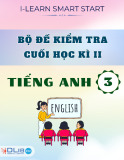
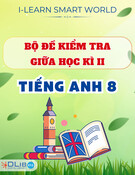
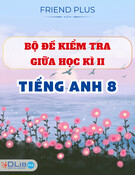
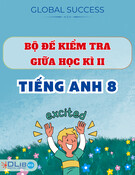
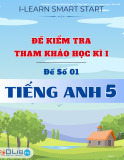

![Đề thi Tiếng Anh có đáp án [kèm lời giải chi tiết]](https://cdn.tailieu.vn/images/document/thumbnail/2025/20250810/duykpmg/135x160/64731754886819.jpg)
